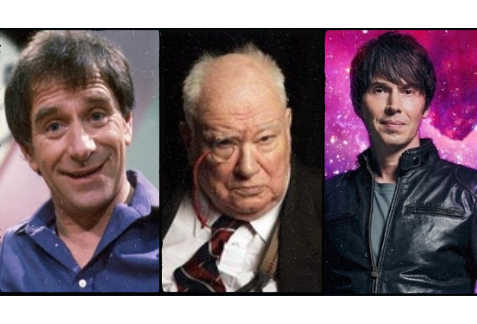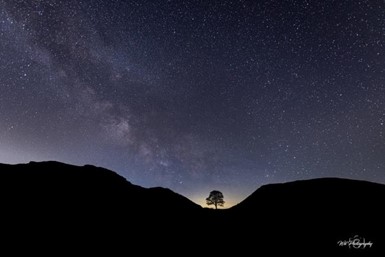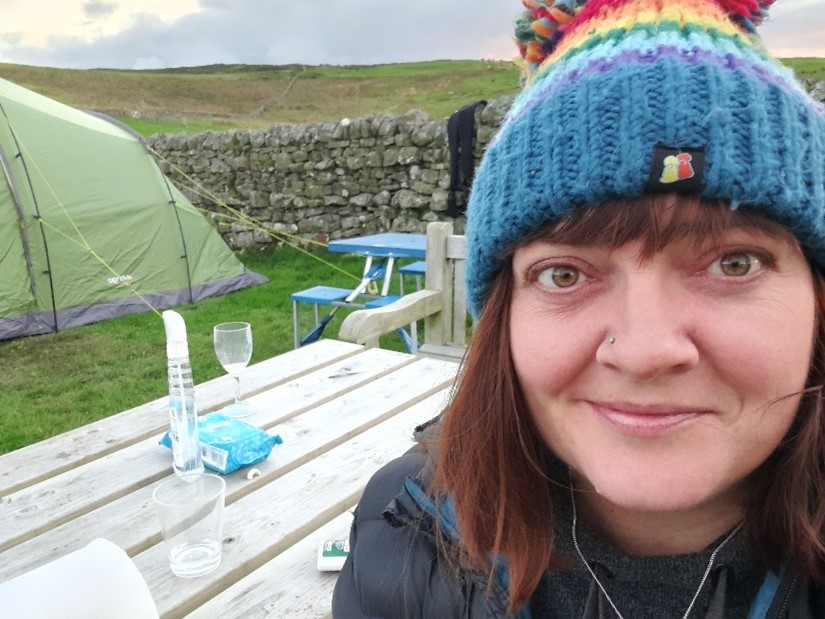
By Dr Suzanne Fairless-Aitken
Ever since I was a little girl, and my Dad gave me his old, battered copy of ‘I Spy…The Night Sky’ I have been obsessed with the stars, planets and the midnight skies.
From the wonderful Johnny Ball’s Think Again series in the 80s, Sir Patrick Moore’s long-running ‘Sky at Night’ programme, right through to the fabulous, Brian Cox and his Wonders of the Universe series in the noughties, my imagination has been fired by looking upwards at our star-studded canopy. Working out from the colour of each twinkle whether the stars are moving away from us (bluish light) or towards us (redder light) always fills me with awe and feeling our small, but significant place in the universe on this incredibly special planet we call home.
We are so fortunate in Northumberland to live in one of the ‘Dark Skies Parks’ where we can often see the silvery belt of our Milky Way belt and even the occasional Aurora Borealis – the seasonal glow of the Northern Lights that has fascinated man for millennia. For centuries people have been guided by these pinpricks of light, whether they were early sailors navigating the globe, wise men crossing sands in search of prophecy and omens, or astrologers matching people up to heavenly types based on constellations and planetary alignment. The heavens have always fascinated us and still lure eccentric millionaires into space today.
The stars are always with us, but even they ‘shift’ over vast periods of time – for example, did you know that ever-bright, Polaris, was not always the North Star? In 3000 BC a faint star called ‘Thuban’, in the constellation of Draco, held the title. Polaris did not become the North Star until AD 500, and in 13,000 more years it will be replaced by ‘Vega’ in the Lyra constellation. We won’t be here to see it, but they show that even fixed points change – there are no constants in the universe.
Often these starry sights have been captured for us by Will Cheung – the astronomer and founder of Twice Brewed Stargazing and his fabulous tele-camera, who posts his amazing pictures online for all to see. These skies are also protected for us by Duncan Wise, who along with Will, are members of the International Dark Skies Organisation whose mission it is to best preserve these spectacular ‘arial parks’ from man-made light-pollution – https://www.darksky.org/light-pollution/. This is not to say we go back in time to darkness, it is just about having the ‘right type of lighting – downward, warm-white’ and factoring it into local planning for updating old lighting and future developments.

I have been lucky enough to work alongside Duncan and have invited him to speak to our new Hexham Town Council full meeting on December 13th about the exciting possibility of making Hexham the UK’s first ‘Dark Skies Town’. We are only 6km from the border of the Dark Skies National Park and as one of the gateway towns into Hadrian’s Wall I feel we have a duty to protect it from further man-made pollution, other towns in the race for a bible-black night are Kendal and Penrith in Cumbria – so we need to get a move on!
New developments are going up all the time and this is great for Hexham, but not so great for our nocturnal wildlife and even us, if light pollution is not better controlled. The blue-white, brighter lights are damaging for nocturnal hunters and breeders as it distracts them and can even cause deadly harm. It also affects our natural biorhythms and healthy human sleep patterns, which is why a warm-white, downward glow is so much better for us and the natural world. This is easy to substitute at the planning stage of all developments, with no extra cost other than thought and consideration for the environment, and this needs to start happening more across all our local councils. I really feel that this is an important project for Hexham, and something we can all get behind.
On a recent family holiday in the middle of the Northumberland National Park darkness, I was amazed to see three planets all in alignment – Uranus, Venus, Mars- next to a waxing moon. It made me think just how special this blue-green rock is – our ‘Goldilocks planet’ – with all conditions for life ‘just right’ for life, in an otherwise barren galaxy. One of my favourite sights is the rather, unromantically-named ‘M42 galaxy’ – which is the only galaxy visible with the naked eye from Earth – it is basically just a fuzzy glow below Orion’s three-star belt – amusingly around the ‘crotch area’. I also love spotting swirls of nebula – those giant nurseries where stars, planets and galaxies are born, and just think on how amazing the universe is.
If you are even remotely interested, I urge you to go to one of the local observatories ‘beginners’ nights’ if you want to learn about it – or buy a Christmas present voucher for someone special. The Kielder Observatory, The Twice-Brewed Inn, The Sill and The Battlesteads Pub at Wark all run inspiring star-gazing evenings – usually accompanied by soup and hot chocolate. I went to one recently and loved learning that ‘Uranus’ (surely only named to make Scouts and Guides giggle) was nearly called ‘George’.
Even with the naked- eye you can see so much, but binoculars and some of the free star gazing apps on your phone are a brilliant help – the power is literally at your fingertips to explore the night sky from the comfort of your armchair. Prof. Brian Cox has recently admitted that he uses these new apps because they are so quick and easy to help you spot key stars and constellations, but also flag up when there is a chance of seeing the Northern Lights or a seasonal meteor shower. On the app stores – Star Walk 2, Sky View Lite, Stap Map, Stellarium, Sky Guide – to name but a few. – that show you exactly what is right above your head here in Northumberland.
When you next look up, and see the Plough, Pegasus, Cassiopeia or Orion the Hunter, just think of how lucky we are to live where we do, and not surrounded by high levels of orangey, urban light pollution, and that we need to protect that precious darkness for future generations to see. Remember, some of those stars sending you their light no longer actually exist, and have long since exploded into supernova, yet are still twinkling in a beautiful, ghostly form, watching over you and reminding you of your special place in the cosmos, and reminding us, as Karen Carpenter once said, ‘we are stardust’.
So put on your woolly hat and gloves and out there to have a look.
‘If the Stars only came out once a year people would look up’ (Henry David Thoreau)

10 TEN TIP FOR STAR-SPOTTING
- Download an app – see recommendations above, and grab some binoculars.
- Dress for the occasion – wrap up warm -even in summer nights it can get very cold.
- Prepare your site – find a spot in your garden where you can see as much of the night sky as possible, away from other houses, tall buildings, and trees. If you don’t have a garden, you can also stargaze from a balcony or front step, or through a skylight.
- Adjust your eyes – once you’re comfy, let your eyes adjust to the darkness. Astronomers call this process ‘dark adaptation’, and it takes about half an hour. Don’t browse on your phone while you wait (its bright screen will ruin your night vision). If you need some light, use a red light torch, or a red bicycle light if you don’t have one.
- Once your eyes have adjusted, you won’t believe how many more stars you can see. You might be able to notice subtle differences in the stars’ colours, which depend on their temperature: the hottest stars are more of a bluish colour, while cooler stars have a yellow, orange or red tint.
- Look for patterns – the stars can be joined up to form patterns. You might recognise one straight away: the saucepan-shaped Plough, which is visible all year round. Very few of the 88 constellations look like the person, animal or object they represent, so you’ll need to use some imagination. I spy and the Ladybird – Night Sky book are good for drawing round them to interpret the pattern into a picture – which is helpful.
- Spot a planet – if you see a bright ‘star’ that isn’t twinkling, it’s almost certainly a planet. Planets are much closer, and their light (reflected from the Sun) comes to us in a thicker beam, which isn’t so easily distorted. There are five planets that can be seen with the naked eye: Mercury, Venus, Mars, Saturn and Jupiter.
- Spot a meteor – as you’re gazing skywards, you might be lucky enough to see a meteor dash across the sky: a shooting star! These showers are seasonal – one of the best annual showers is the Perseids, which peaks this year around 11-13 August. The Leonids in November (6th-30th) are also spectacular – definitely worth standing out in those wintery, northern temperatures.
- Marvel at the Moon – go outside on a cloudless night and reacquaint yourself with our closest celestial neighbour. Impact craters appear as bright patches on the Moon’s surface, while the dark regions, known as lunar maria, are vast plains of solidified lava. A crescent or a gibbous moon can be just as interesting as a full moon, especially when seen through binoculars.
- Have fun!

